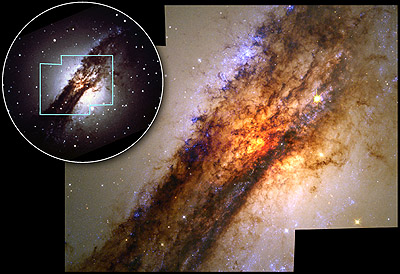|
|
|
Observed by astronomers since 1847, Centaurus A grabbed more attention in recent years because modern instruments detected powerful radio signals, X-rays and gamma rays gushing from the galaxy just 10 million light-years away.
Astronomers realized that Centaurus A was the closest of the "active galaxies", which are galaxies that are spewing out huge amounts of energy and light. Such energy is thought to come from black holes. Most such galaxies are about 100 times farther away.
A black hole, perhaps originating from a collapsed star, is an object so dense that its gravitational power attracts nearby stars and galaxies. Not even light or radio waves can escape its grasp.
New images released Thursday are giving astronomers first close views of a galactic black hole feast.
Special cameras on Hubble captured views of a rapidly spinning disk formed by the final spiral of stars and gas being drawn into the center of the black hole.
As the material accelerates, gravitational energy heats it to millions of degrees, triggering a superheated jet that explodes outward at 1 percent of the speed of light. This jet emits powerful X-ray and radio signals.
Ethan Schreier of the Space Telescope Science Institute in Baltimore said that even though the black hole contains a mass equal to a billion suns, it is compacted into an area about the size of the solar system.
He said the galaxy containing the black hole is immense, perhaps 50 times larger than the Milky Way, home to the Earth and about 100 billion stars.
Galaxies containing black holes have been sighted before, but Schreier said Centaurus A is the closest to the Solar System. Also, he said, it is the first to be studied with the Hubble's infrared camera that can peer into the very center of the dusty stellar formation.
"This instrument allows us to peer into the monster's cave," he said.
Images to be collected by the Hubble later will enable astronomers to gain a better understanding of black holes and the effect they have on material captured into their gravitational trap, he said.

Astronomers have obtained an unprecedented look at the nearest example of galactic cannibalism -- a massive black hole hidden at the center of a nearby giant galaxy that is feeding on a smaller galaxy in a spectacular collision. Such fireworks were common in the early universe, as galaxies formed and evolved, but are rare today.
